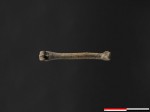 Danish archaeologists have found the skeletal remains of three ancient housecats in Aalborg, northern Jutland. At 2,000 years old, they are by far the oldest domesticated cat remains ever discovered in Denmark. The cat bones were found during an archaeological survey before construction of a new university hospital in Aalborg East. The bones of two of the three cats could be dated from their archaeological context to the 1st century. They will be radiocarbon dated to confirm their age.
Danish archaeologists have found the skeletal remains of three ancient housecats in Aalborg, northern Jutland. At 2,000 years old, they are by far the oldest domesticated cat remains ever discovered in Denmark. The cat bones were found during an archaeological survey before construction of a new university hospital in Aalborg East. The bones of two of the three cats could be dated from their archaeological context to the 1st century. They will be radiocarbon dated to confirm their age.
The settlement was located on the foreland at the narrowest point on the Limfjord, an area which today is considered a marginal area for agriculture. During the Iron Age it was rich pasture land, however, and the settlement took advantage of the excellent grazing to raise livestock. The remains of longhouses from that period have been found at the site, with rare surviving chalk floors and equally well-preserved animals bones, teeth and other zooarchaeological material.
 Excavations took place in 2014-2015, but they found so many different kinds of animal bones that scientific analysis identifying them were only completed this year. Most of the bones came from sheep and/or goats, cattle, horses, livestock that would have been raised, slaughtered and eaten in the settlement. A large number of fish bones attest to the sea-side settlment’s use of marine resources. No remains of game were found, suggesting hunting was not a major source of food for the Iron Age residents.
Excavations took place in 2014-2015, but they found so many different kinds of animal bones that scientific analysis identifying them were only completed this year. Most of the bones came from sheep and/or goats, cattle, horses, livestock that would have been raised, slaughtered and eaten in the settlement. A large number of fish bones attest to the sea-side settlment’s use of marine resources. No remains of game were found, suggesting hunting was not a major source of food for the Iron Age residents.
 There are comparable animal remains at other settlements on the fjord, but the cats are unique. The Limfjord was an important thoroughfare during the Iron Age. Trade networks moved weapons, luxury goods and exotic animals from the south and west of Europe to what is today Denmark. The cats almost certainly came from the Roman Empire.
There are comparable animal remains at other settlements on the fjord, but the cats are unique. The Limfjord was an important thoroughfare during the Iron Age. Trade networks moved weapons, luxury goods and exotic animals from the south and west of Europe to what is today Denmark. The cats almost certainly came from the Roman Empire.
A genetic study reported in the journal Nature this September suggested that cats, all of ancient Egyptian lineage, spread over Europe in waves, reaching northern Europe by making themselves useful to the seafarers of the Viking era.
Cat populations seem to have grown in two waves, the authors found. Middle Eastern wild cats with a particular mitochondrial lineage expanded with early farming communities to the eastern Mediterranean. Geigl suggests that grain stockpiles associated with these early farming communities attracted rodents, which in turn drew wild cats. After seeing the benefit of having cats around, humans might have begun to tame these cats.
Thousands of years later, cats descended from those in Egypt spread rapidly around Eurasia and Africa. A mitochondrial lineage common in Egyptian cat mummies from the end of the fourth century bc to the fourth century ad was also carried by cats in Bulgaria, Turkey and sub-Saharan Africa from around the same time. Sea-faring people probably kept cats to keep rodents in check, says Geigl, whose team also found cat remains with this maternal DNA lineage at a Viking site dating to between the eighth and eleventh century ad in northern Germany.
The discovery of the three cat skeletons in an Iron Age settlement on North Jutland poses a challenge to that view. Of course, the scenarios are not mutually exclusive. It’s entirely possible cats were introduced to the fjord via trade with Rome, direct or otherwise, but didn’t establish themselves until a thousand years later.